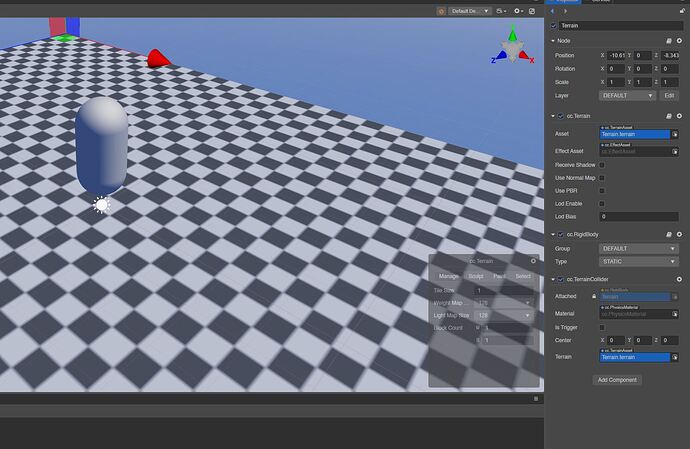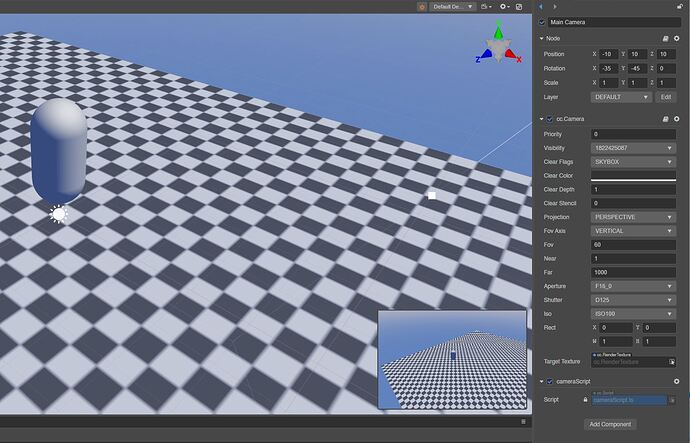Hi All,
I thought I would create a little tutorial on making a first person camera and controls. First person camera and controls will open up many door ways in making many different games so being able to do this quickly and simply is very important. So this tutorial aims to be that. Something you can use time and time again and edit however you like. I’m not going to get into too many specifics.
So to start create a new empty(3D) project. I’m currently using Editor version 3.5.0, although hopefully everything should work in newer versions too.
Once created add a new “Scene” in the Assets panel:
I then add a new Folder and call it “Scripts” I then right click on the folder and create new TypeScript → NewComponent. I make three of these called cameraScript, globalVars and playerScript.

I then create a new terrain in the assets panel called “Terrain”.

Ok now that means our assets are all set up. Now we can make the changes to the scene. I first drag the terrain over to the editor window. Then create a new Capsule.
I then name the Capsule “Player” and position it above the terrain.
I then drag the “playerScript” from the Assets panel over to the object inspector. Then add two new physics components called RigidBody and SphereCollider. The rigidbody gives the character it’s physics. I’ve set mass to 70, Linear and Angular damping both to 0.2, Linear Factor (1,1,1) and Angular Factor to (0,0,0). The SphereCollider gives the object its physics shape. I set the Radius to 2.
I then select the Terrain object. I give it 2 physics components. RigidBody and TerrainCollider. I set the Rigidbody type to static as this terrain won’t be moving anywhere. The TerrainCollider uses the terrain mesh for the physics. I also had to remove the terrain pressing the x next to it and selecting the Terrain.terrain.
Last thing we need to do is select the Main Camera that should already be in your scene. Drag the “cameraScript” from the assets panel over to the object inspector. I also changed the FOV to 60.
You can then edit your terrain and make it look however you want.
So now for the script. I’ve kept it as simple as possible to follow but to make things easier I will explain that the globalVars is where you can add more global variables if you wish. I put the camera node and player node in the character and camera global variables. Which allows for these to be called from anywhere.
cameraScript
import { _decorator, Component, Input, Vec3, input, game, Node } from 'cc';
import { globalVars } from './globalVars';
const { ccclass, property } = _decorator;
@ccclass('cameraScript')
export class cameraScript extends Component {
/* Local Variables */
private mouseXSensitvity: number = 8;
private mouseYSensitvity: number = 5;
private mousePos = new Vec3(0, 0, 0);
/* End Local Variables */
start() {
globalVars.start = 0;
globalVars.camera = this;
document.addEventListener('pointerlockchange', this.lockChange, false);
input.on(Input.EventType.MOUSE_MOVE, this.onMouseMove, this);
input.on(Input.EventType.MOUSE_UP, this.onMouseUp, this);
}
update(deltaTime: number) {
this.node.setPosition(globalVars.character.node.getPosition());
if(globalVars.start == 1){
if(this.mousePos.x >= 300 && this.mousePos.x <= 500){
this.node.setRotationFromEuler(this.mousePos);
} else if(this.mousePos.x < 300){
this.node.setRotationFromEuler(300, this.mousePos.y,0);
} else if(this.mousePos.x > 500){
this.node.setRotationFromEuler(500, this.mousePos.y,0);
}
globalVars.character.node.setRotationFromEuler(new Vec3(0, this.mousePos.y, 0));
}
}
onMouseUp(event:EventMouse){
if(globalVars.start == 0){
if (game.canvas.requestPointerLock) {
game.canvas.requestPointerLock();
}
}
}
lockChange() {
if (document.pointerLockElement === game.canvas ) {
globalVars.start = 1;
} else {
globalVars.start = 3;
setTimeout( () => { globalVars.start = 0; }, 1800 );
}
}
onMouseMove(event:EventMouse){
this.mousePos.x = 330 + event.getLocation().y/this.mouseXSensitvity;
this.mousePos.y = -event.getLocation().x/this.mouseYSensitvity;
}
}
globalVars
import { _decorator, Component } from 'cc';
const { ccclass, property } = _decorator;
@ccclass('globalVars')
export class globalVars extends Component {
/* Global Variables */
public character;
public camera;
public start = 0;
/* End Global Variables */
}
playerScript
import { _decorator, Component, Node, game, input, Input, KeyCode, EventKeyboard, Vec3, SphereCollider, ICollisionEvent, RigidBody } from 'cc';
import { globalVars } from './globalVars';
const { ccclass, property } = _decorator;
@ccclass('PlayerScript')
export class PlayerScript extends Component {
/* Local Variables */
private movementSpeed = 3;
private jumpStrength = 300;
private crouch = 0;
private moveForward = 0;
private moveBackward = 0;
private moveLeft = 0;
private moveRight = 0;
private setSpeed = 0.12;
private maxSpeed = 0;
private speed = 1;
private grounded = false;
private collider: SphereCollider = null!;
private playerHeight = 2;
/* End Local Variables */
start() {
globalVars.character = this;
input.on(Input.EventType.KEY_DOWN, this.onKeyDown, this);
input.on(Input.EventType.KEY_UP, this.onKeyUp, this)
this.node.getComponent(SphereCollider).on('onCollisionStay', this.OnCollisionStay, this);
this.node.getComponent(SphereCollider).on('onCollisionExit', this.OnCollisionExit, this);
this.node.getComponent(SphereCollider).radius = this.playerHeight;
this.maxSpeed = this.setSpeed;
}
OnCollisionStay(event: ICollisionEvent) {
event.contacts.forEach(contact => {
let out: Vec3 = new Vec3();
contact.getWorldNormalOnB(out);
if (Vec3.angle(out, Vec3.UP) < 60) {
this.grounded = true;
}
});
}
OnCollisionExit() {
this.grounded = false;
}
onKeyDown(event: EventKeyboard){
switch(event.keyCode) {
case KeyCode.KEY_A: {
this.moveLeft = 1;
break;}
case KeyCode.KEY_W: {
this.moveForward = 1;
break;}
case KeyCode.KEY_D: {
this.moveRight = 1;
break;}
case KeyCode.KEY_S: {
this.moveBackward = 1;
break;}
case KeyCode.SHIFT_LEFT: {
this.speed = 1.1;
break;}
case KeyCode.KEY_C: {
if(this.crouch == 0){
this.crouch = 1;
this.node.getComponent(RigidBody).clearForces();
this.node.getComponent(SphereCollider).radius = this.playerHeight/1.4;
this.maxSpeed = this.setSpeed/1.4;
} else if(this.crouch == 1){
this.crouch = 0;
this.node.getComponent(SphereCollider).radius = this.playerHeight;
this.maxSpeed = this.setSpeed;
}
break;}
case KeyCode.SPACE: {
if(this.grounded && this.crouch == 0){
this.node.getComponent(RigidBody).applyLocalForce(new Vec3(0,this.jumpStrength*this.node.getComponent(RigidBody).mass,0), new Vec3(0,10,0));
}
break;}
}
}
onKeyUp(event: EventKeyboard){
switch(event.keyCode) {
case KeyCode.KEY_A: {
this.moveLeft = 0;
break;}
case KeyCode.KEY_W: {
this.moveForward = 0;
break;}
case KeyCode.KEY_D: {
this.moveRight = 0;
break;}
case KeyCode.KEY_S: {
this.moveBackward = 0;
break;}
case KeyCode.SHIFT_LEFT: {
this.speed = 1;
break;}
}
}
update(deltaTime: number) {
if(this.moveForward && this.moveLeft){
this.node.getComponent(RigidBody).applyLocalImpulse(new Vec3(-((this.maxSpeed/2)*this.node.getComponent(RigidBody).mass)*this.speed,0,-((this.maxSpeed/2)*this.node.getComponent(RigidBody).mass)*this.speed));
} else if(this.moveForward && this.moveRight){
this.node.getComponent(RigidBody).applyLocalImpulse(new Vec3(((this.maxSpeed/2)*this.node.getComponent(RigidBody).mass)*this.speed,0,-((this.maxSpeed/2)*this.node.getComponent(RigidBody).mass)*this.speed));
} else if(this.moveBackward && this.moveLeft){
this.node.getComponent(RigidBody).applyLocalImpulse(new Vec3(-((this.maxSpeed/2)*this.node.getComponent(RigidBody).mass)*this.speed,0,((this.maxSpeed/4)*this.node.getComponent(RigidBody).mass)*this.speed));
} else if(this.moveBackward && this.moveRight){
this.node.getComponent(RigidBody).applyLocalImpulse(new Vec3(((this.maxSpeed/2)*this.node.getComponent(RigidBody).mass)*this.speed,0,((this.maxSpeed/4)*this.node.getComponent(RigidBody).mass)*this.speed));
} else if(this.moveForward){
this.node.getComponent(RigidBody).applyLocalImpulse(new Vec3(0,0,-(this.maxSpeed*this.node.getComponent(RigidBody).mass)*this.speed));
} else if(this.moveBackward){
this.node.getComponent(RigidBody).applyLocalImpulse(new Vec3(0,0,((this.maxSpeed/2)*this.node.getComponent(RigidBody).mass)*this.speed));
} else if(this.moveLeft){
this.node.getComponent(RigidBody).applyLocalImpulse(new Vec3(-(this.maxSpeed*this.node.getComponent(RigidBody).mass)*this.speed,0,0));
} else if(this.moveRight){
this.node.getComponent(RigidBody).applyLocalImpulse(new Vec3((this.maxSpeed*this.node.getComponent(RigidBody).mass)*this.speed,0,0));
}
}
}
Once you replace your scripts with the above. Save the scripts and save the scene in the editor. Then test the project and you should now have first person controls with AWSD movement, crouch (c key), sprint (Hold left shift) and jump (spacebar). When you click on the window the mouse will disappear. Press the escape key to see the mouse again.
Any questions or additions etc. Please let me know.
Thanks,
-iDev





